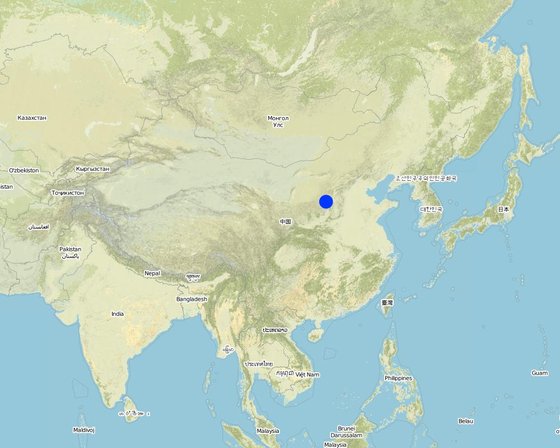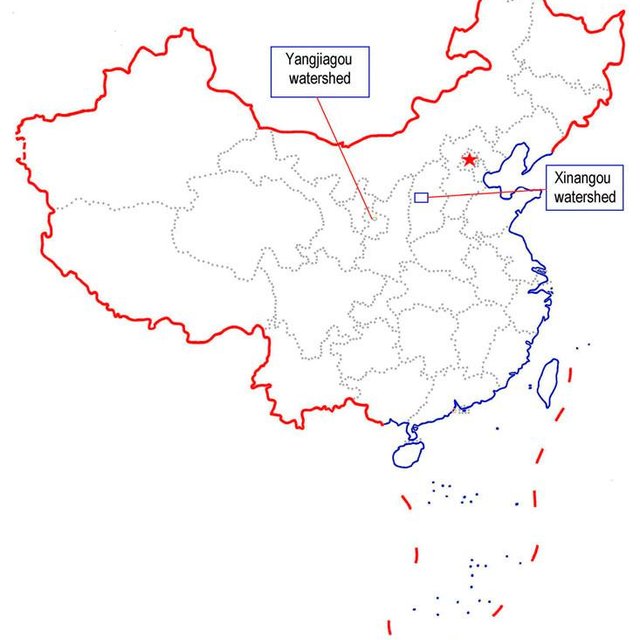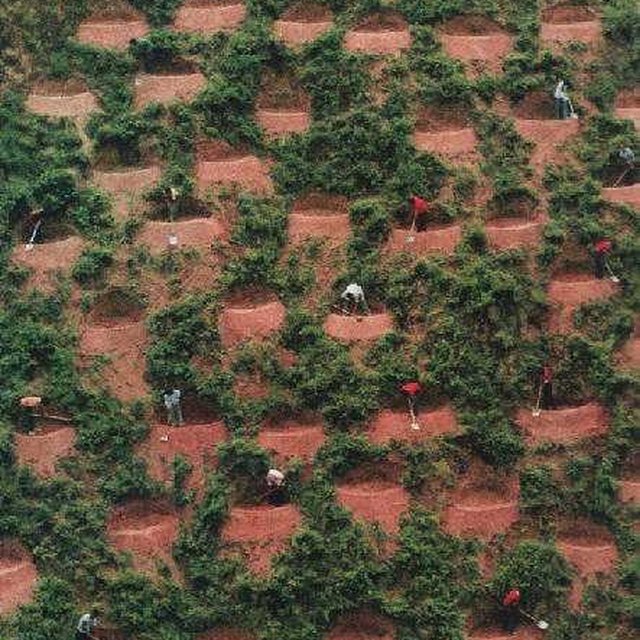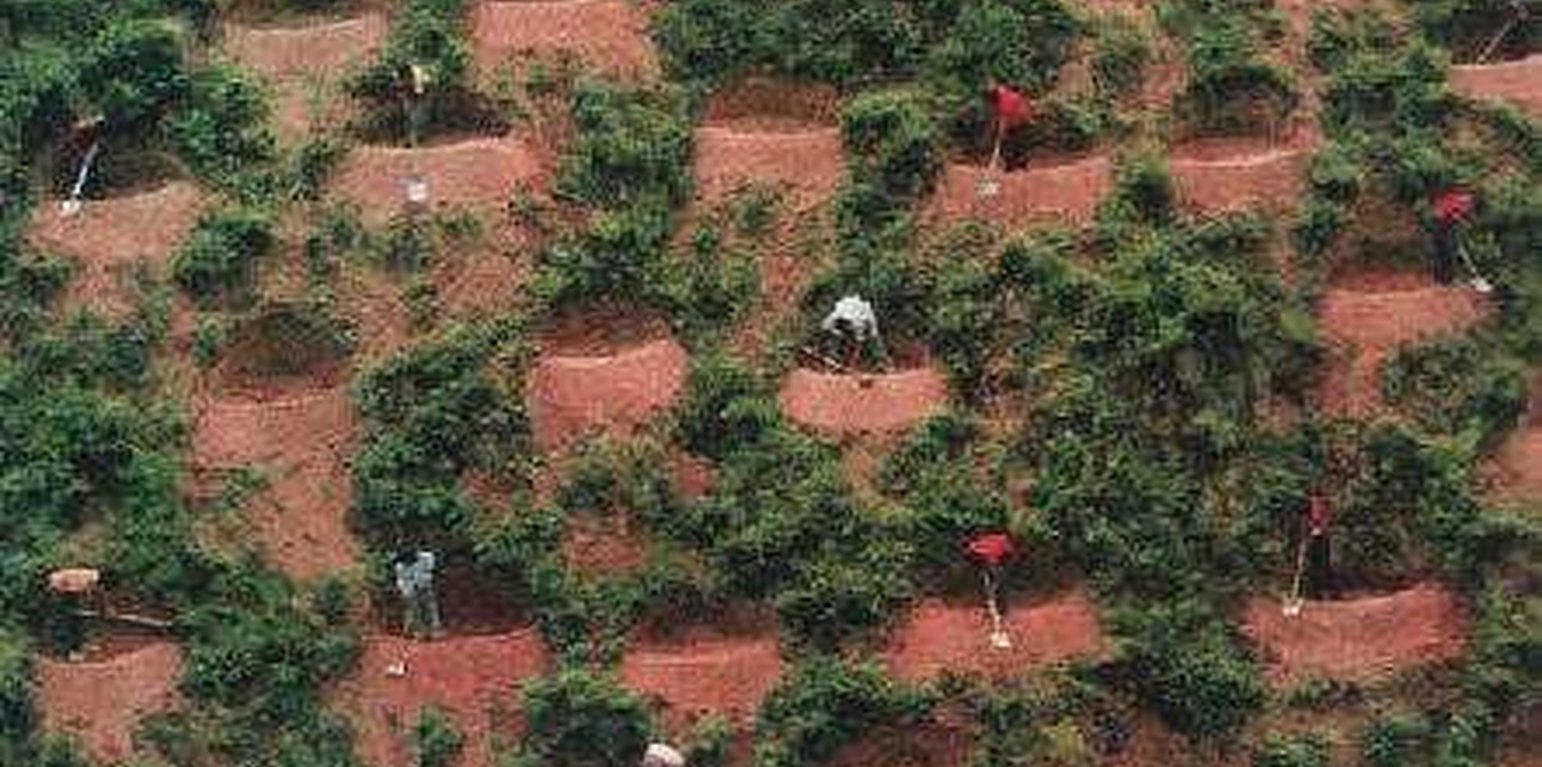Pits
(จีน)
คำอธิบาย
The pits are constructed by hand on steep slope by government investment.
The purpose is to control soil loss and protect environment. Hence the pits are constructed on steep slope. To control watershed erosion, government have to invest. Soil and water conservation bureau is in charge of planning and implementation. Farmers provide labors to construct pits. Tools are shovel and hoes. Pits are constructed on steep slope, so mechanical machine can not be used.
สถานที่

สถานที่: Gansu, Shanxi, จีน
ตำแหน่งทางภูมิศาสตร์ของสถานที่ที่ถูกเลือ
วันที่ริเริ่ม: 1958
ปีที่สิ้นสุด: 2005
ประเภทของแนวทาง
-
แบบดั้งเดิม/ แบบพื้นเมิอง
-
เป็นนวัตกรรมท้องถิ่นล่าสุด/ นวัตกรรมใหม่
-
ใช้โครงงานหรือแผนงานเป็นฐาน

Location of the SWC approach application.

Pits arragement on a steep slope land.
แนวทางการดำเนินการและบรรยากาศการพัฒนาที่เอื้ออํานวย
เป้าหมายหรือวัตถุประสงค์หลักของแนวทาง
The aim is to control soil and water loss and protect environment.
The SLM Approach addressed the following problems: Pit is one of the structural measures to control steep slope soil and water loss. It is difficult to build using mechanical machine but easy to make by hand with simple tools.
เงื่อนไขที่เอื้ออำนวยต่อการนำเอาเทคโนโลยีภายใต้แนวทางนี้ไปปฏิบัติใช้
เงื่อนไขที่เป็นอุปสรรคต่อการนำเอาเทคโนโลยีภายใต้แนวทางนี้ไปปฏิบัติใช้
-
การมีไว้ให้หรือการเข้าถึงแหล่งการเงินและบริการ: Only when government invests, the technology can be implemented
Treatment through the SLM Approach: investment
-
กรอบแนวทางในการดำเนินการด้านกฎหมาย (การถือครองที่ดิน สิทธิในการใช้ที่ดินและน้ำ): The existing land ownership, land use rights / water rights hindered a little the approach implementation Land resources belongs to state and land user can only lease the land for a period of time, land users worry about their land would be transferred to others.
การมีส่วนร่วมและบทบาทของผู้มีส่วนได้เสีย
ผู้มีส่วนได้เสียที่เกี่ยวข้องในแนวทางนี้และบทบาท
| ผู้มีส่วนได้เสียหรือองค์กรที่นำไปปฏิบัติใช้มีส่วนเกี่ยวข้องกับแนวทางนี้อย่างไร |
ระบุผู้มีส่วนได้ส่วนเสีย |
อธิบายบทบาทของผู้มีส่วนได้ส่วนเสีย |
| ผู้ใช้ที่ดินระดับท้องถิ่นหรือชุมชนระดับท้องถิ่น |
existing groups of land users; Specific ethnic groups:: Islam, Korea.; Working land users were mainly men (Men are the main work forces to build the pits.) |
|
| รัฐบาลแห่งชาติ (ผู้วางแผน ผู้ทำการตัดสินใจ) |
|
|
การเกี่ยวข้องของผู้ใช้ที่ดินระดับท้องถิ่นหรือชุมชนระดับท้องถิ่นในช่วงต่าง ๆ ของแนวทาง
ไม่มี
ไม่ลงมือ
จ่ายเงินหรือสนับสนุนจากภายนอก
ปฏิสัมพันธ์
ระดมกำลังด้วยตนเอง
การริเริ่มหรือการจูงใจ
interviews/questionnaires; Land users participate.
การวางแผน
No land users participate
การดำเนินการ
responsibility for major steps; No land users participate
การติดตามตรวจสอบหรือการประเมินผล
No land users participate
Research
No land users participate
การตัดสินใจในการเลือกใช้เทคโนโลยี SLM
การตัดสินใจถูกทำโดย
-
ผู้ใช้ที่ดินเพียงผู้เดียว ( ริเริ่มด้วยตัวเอง)
-
ผู้ใช้ที่ดินเป็นผู้ตัดสินใจหลัก โดยการสนับสนุนจากผู้เชี่ยวชาญ SLM
-
ผู้ลงมือปฏิบัติที่เกี่ยวข้องทั้งหมดในฐานะที่เป็นส่วนรวมของแนวทาง
-
ผู้เชี่ยวชาญ SLM เป็นผู้ตัดสินใจหลัก ที่ติดตามให้คำปรึกษากับผู้ใช้ที่ดิน
-
ผู้เชี่ยวชาญ SLM เพียงผู้เดียว
-
นักการเมืองหรือผู้นำ
การตัดสินใจถูกตัดสินอยู่บนพื้นฐานของ
-
การประเมินความรู้ SLM ที่ได้ทำการบันทึกไว้เป็นอย่างดี (การใช้ข้อมูลในการตัดสินใจ)
-
สิ่งที่ค้นพบจากงานวิจัย
-
ประสบการณ์และความคิดเห็นส่วนตัว (ไม่ได้ลงบันทึกไว้)
การสนับสนุนด้านเทคนิค การสร้างขีดความสามารถ และการจัดการด้านความรู้
กิจกรรมหรือการบริการต่อจากนี้เป็นส่วนหนึ่งของแนวทาง
-
การสร้างขีดความสามารถ / การอบรม
-
การบริการให้คำแนะนำ
-
การเสริมความแข็งแกร่งให้กับสถาบัน (การพัฒนาองค์กร)
-
การติดตามตรวจสอบและประเมินผล
-
การวิจัย
การสร้างสมรรถภาพหรือการอบรม
การจัดอบรมถูกจัดขึ้นสำหรับผู้มีส่วนได้ส่วนเสียต่อไปนี้
-
ผู้ใช้ที่ดิน
-
เจ้าหน้าที่ภาคสนาม / ที่ปรึกษา
-
planners
รูปแบบของการอบรม
-
กำลังดำเนินการ
-
เกษตรกรกับเกษตรกร
-
ใช้พื้นที่ทำการสาธิต
-
จัดการประชุมสู่สาธารณชน
-
จัดคอร์ส
หัวข้อที่อบรม
Mainly setup demonstration areas for visit and illustrate.
การบริการให้คำแนะนำ
การให้คำแนะนำถูกจัดขึ้น
-
ไปเยี่ยมชมสถานที่
-
ที่ศูนย์ถาวร
Name of method used for advisory service: Local government and SWC station (office).; Key elements: Planning, Build pits, Maintaining; 1) Advisory service was carried out through: projects own extension structure and agents 2) Advisory service was carried out through: projects own extension structure and agents; Extension staff: mainly government employees 3) Target groups for extension: land users
Advisory service is quite adequate to ensure the continuation of land conservation activities; At each government level, there is a SWC office which is in charge of SWC activities including extension.
การติดตามตรวจสอบและประเมินผล
area treated aspects were ad hoc monitored through measurements
land users involved aspects were ad hoc monitored through measurements
There were no changes in the Approach as a result of monitoring and evaluation
การวิจัย
การวิจัยกระทำกับหัวข้อต่อไปนี้
-
สังคมวิทยา
-
เศรษฐศาสตร์หรือการตลาด
-
นิเวศวิทยา
-
เทคโนโลยี
Research was carried out on-farm
การสนับสนุนด้านการเงินและวัสดุอุปกรณ์
งบประมาณประจำปีสำหรับองค์ประกอบ SLM เป็นจำนวนดอลลาร์สหรัฐ
-
< 2,000
-
2,000-10,000
-
10,000-100,000
-
10,000-100,000
-
> 1,000,000
Precise annual budget: n.a.
Approach costs were met by the following donors: government (national - state): 100.0%
การบริการหรือแรงจูงใจต่อจากนี้ได้ถูกจัดให้สำหรับผู้ใช้ที่ดิน
-
การสนับสนุนด้านการเงิน / วัสดุอุปกรณ์ให้แก่ผู้ใช้ที่ดิน
-
เงินสนับสนุนสำหรับปัจจัยการผลิต
-
เครดิต
-
แรงจูงใจหรือเครื่องมืออื่น ๆ
ได้รับการช่วยเหลือทางการเงินบางส่วน
ได้รับการช่วยเหลือทางการเงินแบบเต็ม
แรงงานของผู้ใช้ที่ดินคือ
-
สมัครใจ
-
อาหารสำหรับการทำงาน
-
จ่ายเป็นเงินสด
-
ให้ค่าตอบแทนด้วยการสนับสนุนด้านวัสดุอุปกรณ์อื่น ๆ
ผลกระทบและสรุปคำบอกกล่าว
ผลกระทบของแนวทาง
ไม่ใช่
ใช่ เล็กน้อย
ใช่ ปานกลาง
ใช่ อย่างมาก
ช่วยให้ผู้ใช้ที่ดินนำเอาเทคโนโลยี SLMไปใช้และบำรุงรักษาสภาพไว้ได้หรือไม่
The wrapped water by pits can plant SWC trees and other fruit trees.
ปรับปรุงประเด็นของการถือครองที่ดินหรือสิทธิในการใช้ ซึ่งขัดขวางการนำเทคโนโลยีไปใช้ให้ดีขึ้น
Local government can manage it.
The problem is likely to be overcome in the near future. Prolonging the contract period of the leased land.
Did other land users / projects adopt the Approach?
แรงจูงใจหลักของผู้ใช้ที่ดินเพื่อที่จะนำ SLM ไปปฏิบัติใช้
ความยั่งยืนของกิจกรรมของแนวทาง
ผู้ใช้ปที่ดินสามารถทำให้สิ่งต่างๆ ที่ได้ปฏิบัติใช้โดยแนวทางนี้ยั่งยืนได้หรือไม่ (โดยไม่มีการสนับสนุนจากภายนอก)?
บทสรุปหรือบทเรียนที่ได้รับ
จุดแข็ง: มุมมองของผู้ใช้ที่ดิน
-
It is better to make pits in the farming leisure time(winter).
-
It is easy to build a pit
-
low inupt and land users can bear (How to sustain/ enhance this strength: With favourable policies)
จุดแข็ง: ทัศนคติของผู้รวบรวมหรือวิทยากรคนอื่นๆ
-
easy to make pits (How to sustain/ enhance this strength: Repairing and planting trees in pits timely)
-
harvest water on steep slope (How to sustain/ enhance this strength: Reasonable size of pits based on local rainfall.)
-
Better ecological benefits (How to sustain/ enhance this strength: Partly financial support.)
จุดด้อย/ข้อเสีย/ความเสี่ยง: มุมมองของผู้ใช้ที่ดินแก้ไขปัญหาได้อย่างไร
-
Not any economic benefits
Planting economic trees or fruit trees.
-
Not any funds for maintain exsiting pits.
subsidy.
จุดด้อย/ข้อเสีย/ความเสี่ยง: ทัศนคติของผู้รวบรวมหรือวิทยากรคนอื่นๆแก้ไขปัญหาได้อย่างไร
-
Little economical return
Planting economic trees or fruit trees.
การอ้างอิง
วันที่จัดทำเอกสาร: 28 มกราคม 2009
การอัพเดทล่าสุด: 19 กรกฎาคม 2017
วิทยากร
-
Baoyuan Liu (baoyuan@bnu.edu.cn0) - ผู้เชี่ยวชาญ SLM
คำอธิบายฉบับเต็มในฐานข้อมูล WOCAT
การจัดทำเอกสารถูกทำโดย
องค์กร
- Department of Resources and Environmental Science, Beijing Normal University (Department of Resources and Environmental Science, Beijing Normal University) - จีน
โครงการ
การอ้งอิงหลัก
-
Zhou yugui, Zhang cheng. Effectively comprehensive control in Xinangou watershed, 2000.: Soil and Water Conservation Science and Technology in Shanxi, 6, 36-38
-
Wang ling. Pits in soil and stone hilly area, 1984.: Soil and Water Conservation in China. 11, 14-16.
-
Li yanchang. Storage capability and excavating volume of pits, 1984.: Soil and Water Conservation in China. 11, 17-19.
-
Yang yansheng. Technological measures suitable for red earth region in southern China, 1999.: Research of Soil and Water Conservation. 6(2):117-120.
-
Dou yuqin. Hydraulic property and design criterion of pits, 1986.: Bulletin of Soil and Water Conservation.,4,53-58.
-
Shi shengxin, Jiang dingsheng. Impacts of several soil and water conservation measures on strengthening rainfall infiltration and reducing sediment yield, 1994.: Research of Soil and Water Conservation. 1(1): 82-88.
-
Mu Xingmin, Chen jiwei. Effects of measures of soil and water conservation on soil water content in the Loess Plateau, 1996.: Journal of Soil Erosion and Soil and Water Conservation, 5(4):39-41.
-
Mu xingmin, Wang wenlong, Xu xuexuan. The influence of the soil and water conservation on the surface runoff in the watersheds in the gully plateau region of Loess Plateau, 1999.: Journal of Hydraulic, 2:71-75.






